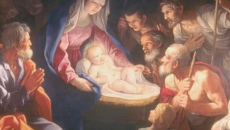
Don’t we all love Christmas time with its celebrations, beautifully wrapped presents, greeting cards, the decorated trees & twinkling lights, wonderful festive food and if we are really lucky, a lovely downfall of snow! A truly magical time of year, bringing family and friends together to celebrate long established customs and traditions
All Christians know that Christmas is the celebration of the birth of Jesus Christ in Bethlehem over 2000 years ago and that we do this on 25th December. But how many of us know why we celebrate on that day as no one actually knows the real birth date of Jesus. No clear date is given in the Bible nor in the writings of early Christians. So why 25th December?
Several different dates were proposed by various Christian groups, but it was not until early in the fourth century that two dates emerged that began to be widely recognised and celebrated, namely 25th December (in the western Roman Empire) and 6th January (in the East).
The first recorded date of Christmas being celebrated on the 25th December was in 336 AD during the time of the Roman Emperor Constantine who had declared Christianity the Empire's favoured religion. Prior to his reign, Christians had endured imprisonment and death at the hands of the Roman Empire, while Pagan gods and goddesses were worshipped freely. A few years later in 350 AD, Pope Julius I declared the 25th to be the official date and in 529 AD Emperor Justinian declared Christmas to be a civic holiday. As to why, there is more than one theory.
A very early Christian tradition said that it was 25th March when Mary was told by the Archangel Gabriel that she would have a very special baby (the Annunciation) which is still celebrated today, and nine months after the 25th March is the 25th December!
December 25th might have also been chosen because the Winter Solstice and the ancient pagan Roman midwinter festivals called 'Saturnalia' and ‘Sol Invictus' took place in December around this date - so it was a time when people already celebrated.
The prominence of Christmas Day increased gradually over the years. During the Middle Ages it was a public festival and the annual indulgence of eating & drinking became more widely celebrated. Following the Protestant Reformation, groups such as the Puritans strongly condemned the celebration of Christmas and at one point during the English Civil War, around 1647, it was in fact banned! The restoration of King Charles II to the throne in 1660 marked the end of Republican rule in England and the ban was lifted.
During the 17th and 18th Centuries people continued to celebrate Christmas with the giving of gifts, decorating their houses with evergreens such as mistletoe, holly and ivy, feasting with their neighbours and giving charity to the poor. But the occasion was falling into decline and by the beginning of the 19th Century it was hardly celebrated at all.

In contrast, by the end of the 19th Century it had become the biggest and most important annual celebration and was the Christmas that we all know and love today. So how did this happen? And aren’t we grateful that it did!
Well, we have the Victorians to thank for much of the modern celebrations associated with Christmas. They revived some of the old traditions and invented and introduced new ones.
The first Christmas card was produced in 1843 and Christmas crackers first made an appearance in 1847. The Christmas tree became popular after a London newspaper published a drawing of the royal family celebrating around a decorated tree in 1848 (a tradition in Germany from Prince Albert’s childhood) and Christmas tree lights were subsequently invented in 1882.The roast turkey became the favoured Christmas meal with it being large enough to feed big families, where previously beef and goose, with rabbit for the poor, had been the main fare.
Charles Dickens is also credited with spreading many of the Christmas traditions in Victorian times. His famous book, ’A Christmas Carol’, published in 1843, was very popular and influenced how Victorian families approached the celebration of Christmas. His book helped to rekindle the joy of Christmas and all these years on is still a firm favourite.
‘A Christmas Carol’ reminds us of a vision of Christmas that is not all about money and wealth, but instead focuses on family and close friends and the joy of giving.
Have a wonderful Christmas everyone.
IMAGE 1: http://antiquitynow.files.wordpress.com/2013/12/a-modern-christmas.jpg

0 Comment:
Be the first one to comment on this article.